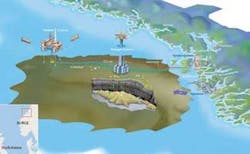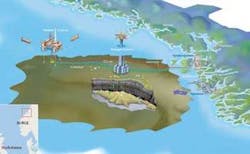CO2 for EOR off Norway under study
Nick Terdre, Contributing Editor
Norske Shell and Statoil’s hope of establishing a value chain for carbon dioxide capture and injection for enhanced oil recovery on the Halten Bank off mid-Norway have met a setback with the finding that injection into the Draugen field, though technically feasible, is not economic. Work is still under way to assess other parts of the value chain.
The joint project, set up in March 2006, involves capturing CO2 from a new gas-fired power plant at Tjeldbergodden, where some of the gas from Statoil’s Heidrun platform is landed, and injecting CO2 into Shell’s Draugen field in a first stage, and afterwards into Heidrun. It would be the world’s largest project using CO2 for enhanced oil recovery, and the first offshore.
The project was welcomed by the minister for petroleum and energy, Odd Roger Enoksen, and others, as CO2 injection for EOR is perceived as offering the double benefit of disposing of an unwanted greenhouse gas while increasing the production of a valuable energy commodity.
Both companies have good credentials for the project. Shell pioneered CO2 for EOR in the 1970s, while Statoil was the first to implement CO2 storage offshore - at the Sleipner field in the North Sea in the 1990s. Statoil also stores CO2 at the In Salah onshore field in Algeria and is preparing to do the same on Snøhvit in the Norwegian Barents Sea.
Challenges at Draugen
However, studies of CO2 injection on Draugen have found the returns in terms of enhanced recovery fall far short of providing a cost benefit, says Shell’s project manager Thorbjørn Nyland. Detailed figures from the project’s findings are not public, but the gap is a large one, he says.
The estimated additional recovery from CO2 injection would be 2-5%. The expected recovery on Draugen is already 66%, a comparatively high proportion. The Draugen reservoir is very homogeneous, which facilitates recovery. In addition, waterflood is already used very effectively. CO2 injection is one of several techniques under consideration to mobilize the remaining oil, especially the oil trapped in the flushed zones. To be selected, CO2 not only would have to give a cost benefit, but a better cost benefit than other options, which include hydrocarbon gas injection and in-fill wells.
In several ways CO2 has advantages over hydrocarbon gas. Draugen’s oil contains relatively little associated gas. Produced gas is used in the first place for power generation on the platform. In the early years, the surplus was injected subsurface for storage, but since then, the surplus has been exported as a source of revenue. By 2012-14, the field should become gas deficient, and if gas is still required for power generation, and possibly injection, it eventually would have to be imported at some cost.
The in-depth studies throw light on the challenges faced by offshore injection of CO2. With a better understanding of the scope of work, it is clear that the required investment would be higher than was first thought likely, Nyland says. Costs mainly would be incurred in drilling additional wells, modifying existing wells and process equipment, and in building and installing new equipment on the platform.
A pipeline also would have to be built to transport the CO2 out to the field, a distance of 120 km (75 mi) from Tjeldbergodden. CO2 would be piped to the field at a pressure sufficient to enable it to be injected without further pressurization. After a time, however, CO2 would start to return to the platform with the produced oil, and compression equipment then would be required on the platform to recycle this CO2 into the reservoir. It would make sense to take the CO2 arriving from shore onto the platform anyway, as it will eventually have to be combined with the stream of reproduced CO2. Some 2-2.5 million metric tons (2.2 to 2.75 million tons) a year of CO2 would be available for injection.
Combating CO2 corrosion
Further costs arise due to the corrosive nature of CO2 when combined with water. This means tubing in the production wells would have to be changed out with stainless or duplex steel, and similar action would have to be taken with parts of the process facilities. Implementing all this work would be time consuming. It is estimated that the platform would have to shut down for up to a year to allow process facilities modification and the installation of new modules.
Another heavy item on the cost side is that about half a dozen new wells would have to be drilled and connected to the platform by flowlines. These would be subsea wells that target the flanks of the field, as do the existing water injection wells.
It also became evident in the course of the studies that the need for fresh CO2 would be more limited than originally anticipated, says Nyland. After several years, there would be sufficient CO2 circulating between the platform and the reservoir and little need for fresh supplies. This situation creates a need for an alternative solution for the CO2. If there is no other client to use it for injection, the surplus CO2 incurs costs while providing no benefits. It has to be stored, which involves drilling a disposal well and installing a pipeline and pump to transport it to the well.
Heidrun studies
While the Draugen part of the studies is complete, work still is under way on the other parts of the value chain. Statoil continues to investigate the costs and benefits attached to CO2 injection into Heidrun, says Kai Bjarne Lima, Statoil’s project manager. No conclusions are available yet, though it is clear that many of the findings of the Draugen study, such as extensive platform modifications, also would apply at Heidrun. A pipeline link would have to be established to Heidrun, which is 120 km (74.5 mi) north of Draugen
The question of optimal timing is being investigated, with an earlier start being taken into consideration now that CO2 injection at Draugen has been ruled out. The studies also are aimed at ensuring that nothing is done on Heidrun that would prevent CO2 injection implementation.
One reason for bringing Draugen and Heidrun together in a joint value chain with CO2 injection is that the timing fits. Though the two fields came onstream at a similar time - in 1993 and 1995 respectively - Draugen has a shorter expected production life, currently expected to end around 2020. Heidrun, on the other hand, is likely to remain onstream into the 2030s. In rough terms, it seemed that Draugen could benefit from CO2 injection in the 2010s and Heidrun in the 2020s.
Power plant hurdles
Studies are also ongoing for the 860 MW gas-fired power plant with carbon capture. These include establishing a commercial model for the power plant, which would have to be economically competitive with other sources of electricity. This is a challenge, as Norway’s primary source of energy is hydroelectric power, Lima points out. However there have been shortages in recent years when the water reservoirs have been deficient. And a shortage is forecast for mid-Norway in coming years as demand grows strongly.
Also part of the equation is the price paid for the gas that would come from Heidrun or other fields in the area. Most of Norway’s gas is exported - the country is Europe’s leading gas exporter - so the price paid would have to compete with that fetched by exports. There have been attempts to make gas-fired power a reality in Norway, but only now is the first such project under construction, at the Kårstø gas terminal.
The project also is qualifying carbon capture technology from three vendors: Fluor, which is performing qualification testing in Spain; Mitsubishi Heavy Industries, which is testing in Japan; and Canadian company Cansolv, which is testing at Risavika outside Stavanger. All three offer methods based on the use of amine solvents. The results of this evaluation will be available in late autumn.
These technologies all involve capture of the CO2 in the flue gas, and therefore are suitable for retrofit to existing plants, including coal-fired plants. In the case of the Tjeldbergodden application, it would be possible to design the capture technology optimally to fit in with the power plant.
The work done by the project so far indicates there would be integration benefits between the power plant and the capture plant. Such benefits could include the use of high-pressure steam generated by duct firing to drive the CO2 export pump and amine regeneration and flue gas cooling to improve CO2 capture.
In previous studies, the carbon capture technologies have shown to be energy intensive, taking 15-18% of the electric power output. However, work in the Halten project has established that the requirement can be reduced to as low as 2%, Lima says.
Offshore electrification
Another element in the value chain is the use of the generated power to run the offshore platforms. This could be an interesting solution for Draugen, in view of its foreseen gas deficiency. No platforms in the Norwegian Sea currently run by power from shore, so offshore electrification in the area would be starting from scratch. There could be interesting economies of scale to be realized, which is why Statoil is carrying out a screening study for the whole Halten Bank area. In addition to Heidrun, this includes the Åsgard and Kristin fields, and Tyrihans, which is in the process of being tied back to Kristin, as well as Norsk Hydro’s Njord field near Draugen.
Draugen’s power requirement would be 45-50 MW, and Heidrun’s 50-70 MW. Area-wide electrification would use, at most, half of the power plant’s capacity.
The project also is studying how the government could contribute to making carbon capture and injection a reality. It is accepted in principle that the government has a role to play. This could take several forms, such as setting helpful frame conditions, including a favorable tax framework, and providing financial support as the main contributor to the carbon capture and storage part of the project. None of the contributions alone is likely to resolve the issue - in fact, it is likely that all will be needed.
The detailed cost estimates being developed in the Halten project should help better define what forms the government role should take and the extent to which financial assistance would be needed. This is clearly a tricky area, as government subsidies are ruled out. In this respect, Norway, as a member of the European Economic Agreement, is subject to European Union law. Moves are afoot within the EU to investigate how public funds can be deployed to make CCS economically viable without violating free market principles.
Results from the Halten project, a 50/50 joint venture between Shell and Statoil, will be presented toward year-end. Part of the work, such as the study of injection on the respective fields, pertains exclusively to each license. Other parts, including the work on the power plant and capture technology, have been carried out jointly and will be presented in a joint report. The reports will also be made available to the government.

